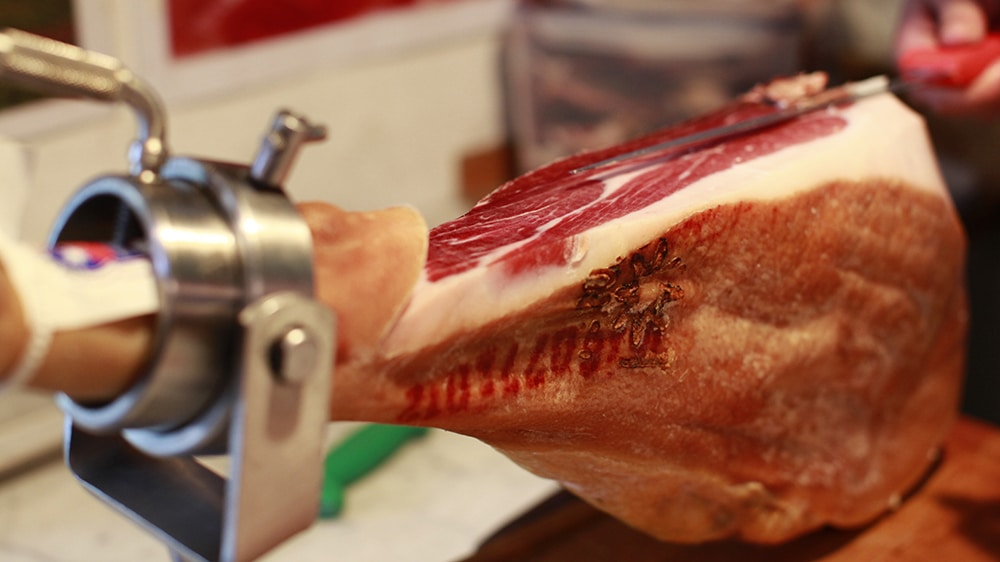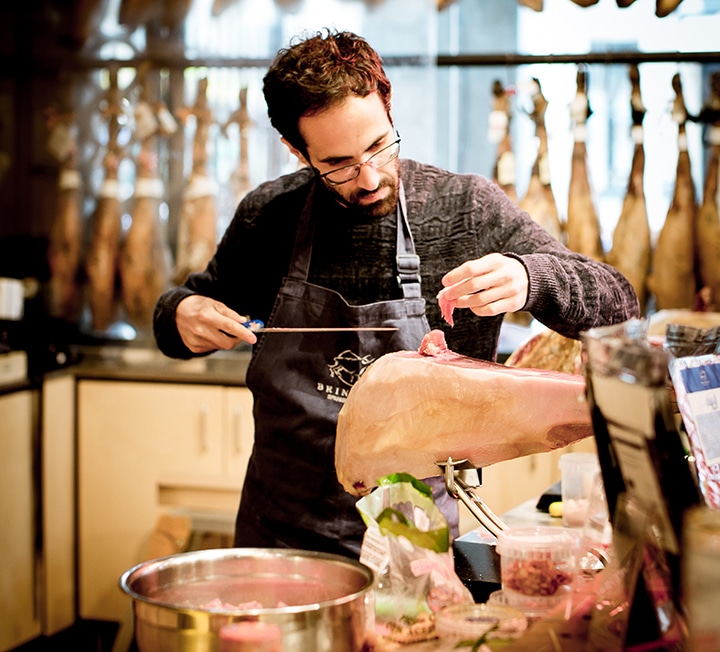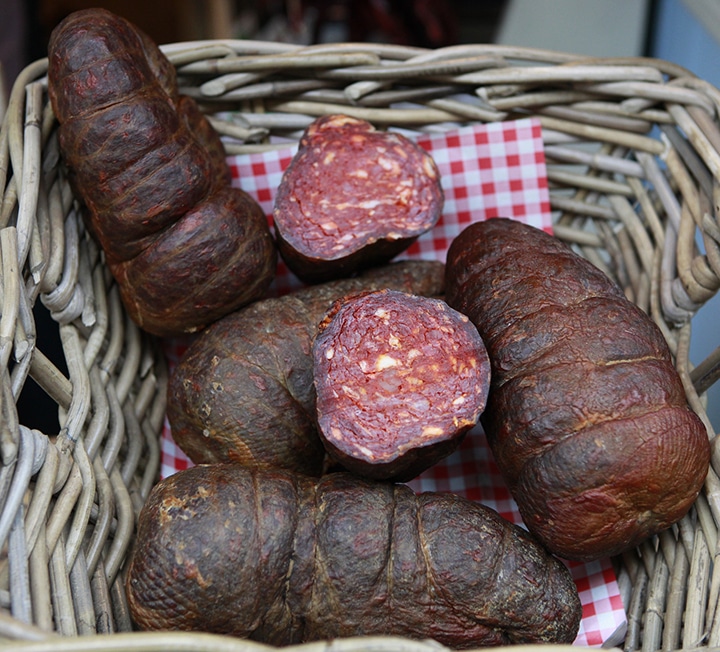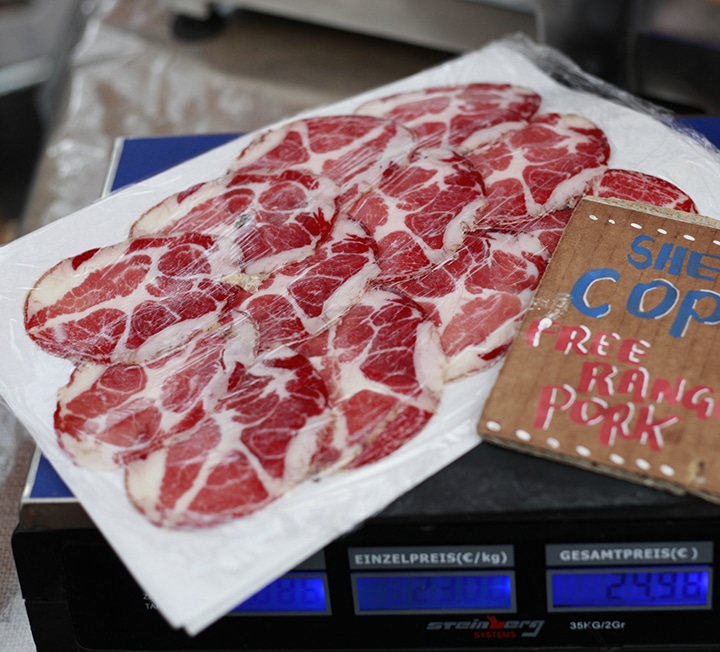Cut & dried: Spanish charcutería
Ed Smith takes a look at the nature of Spanish charcutería and explains what distinguishes this country’s cured meats from other classic European traditions


“THERE ARE DISSERTATIONS TO BE WRITTEN ON THE SUBJECT OF THE IBERIAN BLACK PIG AND THE JAMÓN MADE FROM IT”
The cured meats of Spain can be broken down into two broad categories: muscle meats and sausages, with a sub or arguably third category of ‘soft and spreadable’. Most of the products are pork-based, though there’s a tendency towards certain cuts of beef and ox, too. All of which, I hear you screaming, is more or less the same as the traditional meats of Italy, France, Germany, Scandinavia and beyond – and indeed what we’ve already discussed so far in this series.
What makes charcutería quintessentially Spanish, then? Again, as with the other countries we’ve discussed, region and terroir are important to specific styles and specialities. We’ll touch on this a little bit below, and you should get chatting to the people carving the hams at the Brindisa counter for more detail.
For me, there are two things in particular that make many (not all, but many) of Spain’s cured meats stand out: paprika and the Iberian black pig.
Paprika
So much of Spain’s cured meat is dusted or rippled with paprika – the ground red spice made from dried and sometimes smoked sweet peppers.
Paprika is the defining ingredient of chorizo – one of those rare food products that bears its original, native-tongue label wherever in the world it is reproduced or consumed (and on the rare occasion a paprika-seasoned sausage is not called chorizo, then it’s still labelled a ‘Spanish sausage’).
Paprika is also, as we’ll see, used in and on a number of other Spanish cured meats. In fact, if you take jamón out of the equation, cured meats not seasoned with paprika are very much in the minority.
The Iberian black pig
There are dissertations to be written on the subject of the Iberian black pig (and indeed jamón made from it). At this level, perhaps we can simply say that this pig – and cross breeds of it – make superior cured meats because both the levels and particular qualities of the intramuscular fat appear nearly perfect for making rich, smooth-textured and creamy meats.
The pig’s fame is largely down to jamón produced in the central and southwestern regions and centres of Huelva, Córdoba, Extremadura, Salamanca and Seville. However, as jamón is merely the ham, or rear leg of a pig, there’s much more pork to go around. You can also find chorizo, plainer sausages, loin and more made from the rest of the carcass, and they also carry the same rich, smooth, creamy qualities as the ham.
When you see ‘Iberico’ on a menu or a label, that means the pig the product is made from is (or is a cross of) an Iberian black pig.
Jamón
As mentioned, jamón is made from the back leg of a pig. In that respect, it’s essentially the same product as Italian prosciutto – salted, larded and air-dried for between nine and 48 months. A key difference to the end-product is that whereas Italians slice their hams into wafer-thin handkerchiefs using a mechanical slicer, most Spanish hams are hand-carved. It has been suggested that this is largely because the Italian industry embraced machinery faster than the Spaniards. But there must also be something in the character of Spanish hams that they taste particularly good carved into thin squares.
The most iconic Spanish ham (and perhaps the single most iconic Spanish thing?!) is jamón ibérico.

As with the Iberian black pig used for this, there is much to be written – and not so much room for it here. In brief, then, the creme de la creme of Spanish jamónes are those that fall under the four classified grades of jamón ibérico. Diet, breed and living conditions determine which grade of jamón their meat will become, though the common theme of the highest quality (jamón ibérico de bellota) is that those pigs were fed on acorns.
Jamón ibérico differs in taste and texture depending not just on its breeding and feeding grade, but also the area the leg is reared and cured in, and the length of time it has been dried.
Clear as mud? Frankly, the best thing to do to clear this all up is to head to Brindisa to taste the three or four different hams they have been carving at any one time, decide which you like best (is it sweet, nutty, rich?), and take a pack of freshly carved meat home.
It should also be noted that other Spanish hams are available. Serrano ham, ‘mountain ham’ cured from anything other than an Iberian black pig, is less expensive, but often still of a good quality.
Other muscle meats
— Lomo: The loin of a pig. Whereas Italian cured loin tends to include a thick piece of back fat over the top (it looks much like back bacon or a bacon chop), Spanish lomo looks more like a lean cylinder of meat; the eye of the chop. Very often the lomo will be dusted with chorizo. Though the lack of a layer of fat might in theory lead to a particularly lean meat, the loins of Iberian black pigs are rippled with intramuscular fat, and so are still a joy to eat once cured and dried. In some regions – like Extremadura – two loins are placed together and encased like a sausage. This is known as ‘lomo doblado’.
— Belly, coppa: Cured belly (pancetta and bacon) and collar (coppa-style) meats do exist in Spain, though they’re not as quintessentially Spanish as other varieties mentioned here.
Sausages
— Chorizo: Not so much a type of sausage, more a genre: chorizo can be semi-cured (so need to be cooked), fully cured and dried, smoked, hot, spicy, sweet, super fatty or fairly lean, thinly sliced or thickly chunked, made from Iberian black pigs, or any other pig, and made all over Spain (and beyond). The thing that links them all is paprika. As with jamón, head to Brindisa and engross yourself in their rusty-coloured meat counter and fridges.
— Chistorra: A thin ‘snacking’ style of chorizo made in the Basque Country and Navarre region – perhaps areas traditionally suited to sausages that cure and dry quickly.
— Fuet: A hard, usually relatively thin and long sausage from Catalonia. Typically, the casing will be covered in a white mould. The meat is finely ground, dried to quite a firm texture, and characteristically porky, with just black pepper and a little garlic as the seasoning.
— Salchichón: Also relatively finely ground pork, and generally flavoured only with black pepper and garlic. But a slightly wider sausage than fuet. Sometimes smoked.
— Morcon: Difficult to know whether this should be labelled a sausage or a muscle meat, such is the size of meat pieces pressed within the sausage-shaped casing. It’s an Extremaduran speciality, so made with the pork of Iberian black pig, and laced with a little paprika too.
— Morcilla: Spanish blood sausage, often (but not always) bulked up with short grain rice and usually more heavily spiced than a classic British black pudding. Huge variety across regions. Generally an ingredient to be cooked, though pre-cooked sausages and pastes exist too.
Spreadable
— Sobrasada: A fully cured, spreadable style of cured meat, similar to Italian nduja, except that the redness of sobrasada comes from typically mild paprika rather than fresh and fiery Calabrian chillies. Spread on toast or crackers, or use to flavour tomato or cream sauces.
Non-pork-based meats
– Cecina: Some Spanish cured meats are non-pork based. Perhaps the best-known is cecina, which is cured, air-dried and sometimes smoked beef butchered from the muscles in the hind leg of a cow. It’s usually quite dry and intensely flavoured and needs to be sliced very finely. Northwest Spain is a particular producer of cecina – an area, as it happens, where Iberian pigs are not farmed. This area also produces chorizo using both beef (de vaca) and ox (de buey).
The ultimate board of Spanish charcutería
If you plan on compiling a Spanish meat board, it’d be worth trying to balance the amount of paprika and also the particular richness of Spanish charcutería, so as not to blast away your taste buds. I’d personally limit the board to just three different meats: perhaps a lomo, a chorizo and some Cecina – plus a separate plateful of jamón ibérico de bellota, served at body temperature.
Where to shop for Spanish charcutería at Borough Market
At Brindisa, of course! An emporium of Spanish produce and the importers of the finest charcutería.
Read Ed’s recipe for hot smoked chorizo croquetas.


